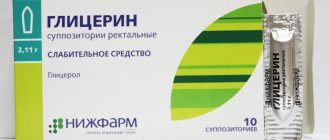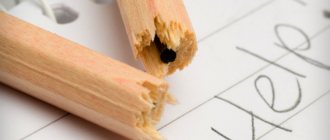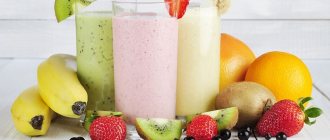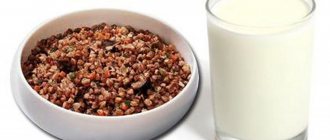Food for colon cleansing
Nutrition to cleanse the intestines is a change in diet, the purpose of which is to influence the muscular structures of the intestinal tract, stimulate natural bowel movements, and also enhance metabolic processes. Therapeutic nutrition is perfect as a preparation for radical methods of “cleansing” with medications, before short-term and long-term fasting.
The lower parts of the intestinal tract perform many different functions, so stagnant feces and deposits of natural waste as a result of the body’s activities affect the person’s condition as a whole.
And, as a result, a person faces problems such as:
- impaired absorption of nutrients - reduces their flow into vital organs and systems;
- violation of secretion - makes it difficult to form and remove feces;
- coarse and old feces damage the intestinal mucosa, leading to inflammation, hemorrhoids, and bleeding.
In addition, one of the causes of neoplasms in the intestines, including those prone to malignancy, is the regular consumption of fatty and fried foods. Thus, dietary nutrition is the prevention of intestinal polyps and other common gastrointestinal diseases.
Many clinicians have doubts about tens of kilos of fecal deposits in the intestines, as evidenced by many sources on Internet resources, but periodic cleansing is necessary for the overall health of the intestines.
Basic principles of therapeutic nutrition
The basic principles of nutrition are:
- Active drinking regimen (fresh juices, herbal decoctions, green tea, berry fruit drinks, jelly);
- Plentiful amount of fiber (fresh vegetables, fruits, as well as separately purchased chopped fiber);
- Compliance with diet, sleep and wakefulness;
- Reducing stress and psycho-emotional tension;
- Elimination of harmful products.
Along with a cleansing diet, an active lifestyle and sports are recommended to stimulate the evacuation of feces. Physical inactivity and a sedentary lifestyle aggravate the situation and contribute to constipation. An active lifestyle along with a cleansing diet can significantly improve the effect of nutritional correction and restore the function of the intestinal tract.
The total duration of the treatment course is 10-14 days. Doctors recommend starting with 3-5 days so that the body gets used to the change in diet.
The menu cannot be called hungry, so no special willpower is required. As a result of cleansing, natural bowel movements are restored, several extra pounds are lost, and the general condition of the body improves.
Body pollution
Toxins and harmful substances in the body form an ideal environment in which they form pathogenic microflora and provoke the production of large numbers of bacteria that poison the entire body.
Consuming large amounts of spicy and unhealthy foods and a sedentary lifestyle negatively affects the functioning of the digestive system and leads to fecal stagnation. Over the course of forty years of life, a person can retain about forty kilograms of fecal stones in the body, which are considered sources of habitat for more than ten kilograms of parasites.
We also recommend reading:
Garlic tincture: recipe, indications for use, benefits and harm Lily of the valley plant: description, benefits and harm of its flowers and berries Deep facial cleansing at home Detoxification of the body: 4 principles of cleansing at home
To cleanse the intestines, a number of effective therapies and traditional methods are used that will protect against the development of intoxication with toxins that accumulate in the body over decades.
Who is prohibited from performing the procedure
Gastric lavage is considered a safe procedure for the human body if carried out with clean water and only after consultation with the attending physician. Despite the great benefits of this procedure for the intestines, you must also take into account some restrictions under which it is prohibited to resort to it.
It is forbidden to perform colon lavage if:
pregnancy;- vaginal prolapse;
- menstrual cycle;
- diseases of the large intestine;
- failure in the kidneys and heart;
- hypertension of the third degree of damage.
Colon lavage is contraindicated in the following human lesions: acute stage of Crohn's disease, ulcerative colitis, severe hemorrhoids, diverticulitis.
You need to be very careful about the health of your intestines, since this organ is exposed to the most severe pollution during its work. A healthy and clean intestine is considered the basis of a healthy body.
Colon cleansing foods
Cleansing the intestines with nutrition occurs due to coarse dietary fiber - cellulose. Like a broom, fiber cleanses the walls of the intestinal tract, helps remove impurities, excess fluid, and form feces. There are even special salads with the unambiguous name “Brush” or “Broom” (the recipe for the “Brush” salad for cleansing the intestines is right here).
When fiber enters the stomach with water or kefir, it is not digested and enters the intestinal tract in undissolved form. In the intestinal lumens, fiber swells, stimulates the contraction of the muscle structures of the organ, and feces come out.
It is recommended to eat the following foods daily that cleanse the intestines::
- Freshly squeezed vegetable, berry or fruit juices (despite the liquid form, the juice contains up to 60% coarse fiber);
- Bran, dry fiber, flaxseed flour to cleanse the intestines - these products are an indispensable component in a cleansing diet;
- Apples, kiwi, pears and dried fruits are an additional source of fiber;
- Citrus fruits are ideal fat burners, natural vitamin C, and are necessary for cleansing procedures;
- Pomegranates are a unique fruit that contains high concentrations of antioxidants that bind and remove toxic compounds;
- Whole grain porridge and bran bread are rich in vitamin B.
The consumption of bran and dry fiber requires plenty of drinking. Otherwise, the opposite effect occurs and constipation occurs.
Pumpkin, garlic (they have a powerful antiseptic and antiparasitic effect), greens in large quantities and some spices, such as ginger or turmeric, are suitable for cleansing the intestines.
Turmeric for colon cleansing
Turmeric is an Indian spice and is translated from Sanskrit as “expelling worms from the body,” “improving appearance,” “giving harmony.” Such epithets are due to the strong therapeutic effect on the gastrointestinal tract and various neoplasms on internal organs.
Turmeric contains an abundance of iron, phosphorus, iodine, calcium and multivitamins.
The spice has the following effects on the intestinal tract::
- removal of putrefactive microflora;
- cleansing of fecal stones and mucous deposits;
- providing antibacterial and antiparasitic effects;
- stimulation of muscle contractility;
- normalization of pancreatic function.
There is evidence that turmeric can stop the progression of the oncological process.
At the same time, turmeric restores the balance of intestinal microflora and eliminates signs of dyspeptic disorders.
Recipes with turmeric
There are several recipes for preparing turmeric to cleanse the intestines, we will give 2 easy to prepare:
- With honey and milk . Add 1 tbsp to 100 ml of boiling water. spoon of spice and 200 ml of milk, put on fire until boiling. After cooling, add 1 tbsp to the mixture. a spoonful of honey and drink warm in the morning on an empty stomach. After a week, the drink is taken 2 times a day: in the morning and at night.
- With ginger and cinnamon . Add 1 tbsp to 500 ml of boiling water. a spoonful of turmeric, a pinch of cinnamon, 100 grams of chopped ginger, 1 teaspoon of black long tea. The composition is brought to a boil over low heat, infused, cooled and filtered. Then combine with 500 ml of kefir and drink 2-3 times during the day.
The recipe with ginger is not suitable for people with exacerbation of gastritis or peptic ulcers. It is not recommended to drink the drink if you have an individual intolerance to the ingredients or allergies.
What foods improve bowel function?
Fiber is found in vegetables, berries and fruits, cereals, nuts, and seeds. Cellulose is not digested in the intestines and is almost completely excreted unchanged from the body. It increases in size and, passing through the intestinal tract, “collects” toxins and wastes, cholesterol, and promotes the passage of feces.
Dietary fiber also stimulates gastrointestinal motility, causing smooth muscles to contract more intensely. Soluble fiber (resins, pectin, inulin) is broken down by microorganisms that populate the large intestine, and they, in turn, normalize the acidity level.
An alkaline environment is necessary for beneficial bacteria and is not suitable for the development of pathogenic microflora. In addition, resins and pectin can slow down the absorption of glucose and thereby normalize blood sugar levels. A lot of fiber is found in bran, legumes, wholemeal products, buckwheat, oatmeal, corn, millet, and nuts.
What to eat for constipation?
Beetroot, carrots, zucchini, pumpkin, cucumber, tomato, eggplant, and artichoke are rich in dietary fiber. Among fruits, preference should be given to apples, kiwi, pear, melon, watermelon, banana.
There is a lot of fiber in strawberries, raspberries, prunes, dried apricots, and dried figs. There are coarse fibers in white cabbage, radishes, radishes, so if you have gastrointestinal diseases, then it is better to avoid them altogether.
To cleanse the intestines, you can buy fiber from flax seeds or milk thistle. It should be taken three times a day half an hour before meals for a month. It will not only help cleanse the intestines, but also get rid of extra pounds, as it makes you feel full for a long time.
When cleaning this way, you need to carefully monitor the amount of liquid you consume, since fiber swells only if there is enough water.
You should drink 20–30% more free liquid than required. On the first day of the fiber cleanse, you need to eat a little and gradually increase the dose to a tablespoon, this way you will be able to avoid bloating. Anamnesis should also be taken into account, since if you are prone to diarrhea and inflammatory processes in the gastrointestinal tract, fiber can be harmful.
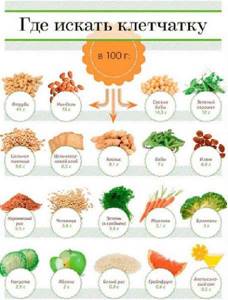
Before consuming increased amounts of dietary fiber, you should consult your doctor.
Fruits and berries are rich in organic acids. These substances enhance intestinal motility, normalize stool, suppress the growth of putrefactive bacteria and fermentation, stimulate the secretion of gastric juice, and therefore accelerate digestion. These acid properties are achieved by changing the pH level in the gastrointestinal tract. Formic, malic, tartaric, lactic, oxalic, citric and other acids are useful.
Lemons, cranberries, currants, rowan berries, cherries, pomegranates, tangerines, grapefruits, pineapples, peaches, grapes, and cherry plums lead in the content of useful acids. Organic substances not only improve digestion, but also increase the body's endurance, eliminate chronic fatigue, increase muscle tone, eliminate headaches and muscle spasms.
Fermented milk products are absorbed faster in the body, since milk proteins are already partially broken down by bacteria and fungi. Lactic acid contained in drinks does not allow putrefactive bacteria to multiply, the waste products of which negatively affect the intestinal mucosa and require increased liver function.
Fermented drinks contain natural antibacterial substances that can resist infections. They also improve intestinal motility and reduce gas formation. Fermented milk products include cottage cheese, yogurt, kefir, yogurt, acidophilus, fermented baked milk, cheese, and baked milk.
Thus, during the diet, you need to eat foods that cleanse the intestines every day:
- bran;
- fresh juices;
- dairy products;
- vegetables;
- green apples and citrus fruits;
- infusion of chamomile, dandelion or thyme;
- porridge;
- whole wheat bread.
The list of products is quite diverse, so such a diet will have a better effect on the body than restrictive short-term diets.
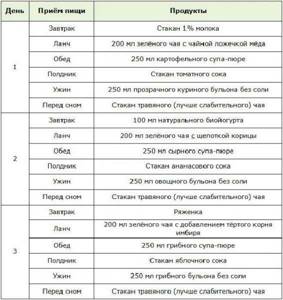
Sample menu for three days
Diet for colon cleansing and weight loss in 10 days
The cleansing menu is well tolerated and does not cause a strong feeling of hunger. Doctors recommend a step-by-step approach to cleansing the intestines over 10 days, for example, 1-3 days in the first 2 weeks.
It is important to prepare the body for a new diet.
A few days before cleansing it is recommended:
- Maintain an active drinking regime (in the absence of contraindications);
- Go on a low-carb diet;
- Start cooking food by steaming, boiling, or baking.
Menu for 5 days + weekends
- Day 1 . Breakfast: barley porridge with water, crispbread with curd cheese, rosehip decoction.
- Lunch: chicken broth with vegetables and crackers, green tea without sugar.
- Afternoon snack: zucchini casserole with cheese, thick jelly.
- Dinner: boiled buckwheat, pink salmon steak, prunes with kefir at night.
- Breakfast: a mixture of nuts, dried apricots or prunes with honey, warm milk with turmeric.
- Breakfast: 300 ml of green tea, crackers, hard cheese.
- Breakfast: rice porridge with milk, sandwich with cottage cheese, coffee.
- Breakfast: oatmeal with prunes, a glass of black tea with milk and sugar.
On weekends, you can completely switch to drinking, thick jelly and crackers, sleep and relax more.
Nutritionists say that without starving you can lose 3-5 kg in a week. Within a week, the process of natural bowel movements improves and the appearance of the skin improves.
It is recommended to eat in frequent small portions 5-6 times a day. In order not to get tired in the kitchen, you can divide the lunch portion into several times. Between meals you can eat dried fruits, fresh vegetables and fruits.
Best Recipes
Modern cooking offers many different delicious recipes for cleansing the intestinal tract and losing weight. Among them are delicious fruit and vegetable cocktails and smoothies that act as a charge of health for the entire body.
Cleansing cocktails
- Recipe No. 1 . A few small tomatoes, 1 cucumber, some dandelion flowers, a pinch of broccoli, celery are mixed in a blender and drunk 200 ml throughout the day.
- Recipe No. 2 . Apricots, peaches, green salad, celery are mixed, left for 30 minutes and drunk.
You can use almost any combination of fruits and vegetables.
It is recommended to make cocktails using a blender bowl. As additives you can use turmeric, ginger, prunes, dried apricots.
Smoothie recipes in a blender
A smoothie is a delicious drink with a thick consistency that is prepared using a blender. Delicious combinations can not only cleanse the intestines, but also please your household with a delicious dessert.
- Recipe No. 1 . Strawberries and milk. Add 1 tbsp of fresh or frozen strawberries to 1 liter of milk. Additionally, cut 1 banana and add a pinch of cinnamon and turmeric. This recipe will not only cleanse and nourish the body, but can also replace a full meal.
- Recipe No. 2 . Milk and orange. 500 ml orange juice, 400 ml milk, sugar to taste and banana. Mix the mixture thoroughly with a blender and drink immediately after preparation.
It is not recommended to add pear to fruit smoothies due to poor compatibility. Pear is more suitable for vegetable drinks.


